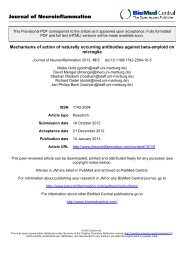View PDF - Journal of Neuroinflammation
View PDF - Journal of Neuroinflammation
View PDF - Journal of Neuroinflammation
You also want an ePaper? Increase the reach of your titles
YUMPU automatically turns print PDFs into web optimized ePapers that Google loves.
Krstic et al. <strong>Journal</strong> <strong>of</strong> <strong>Neuroinflammation</strong> 2012, 9:151 Page 4 <strong>of</strong> 23<br />
http://www.jneuroinflammation.com/content/9/1/151<br />
(pH 7.4), followed by 4% paraformaldehyde in PBS<br />
(Sigma-Aldrich). The brains were post-fixed for 4 hours at<br />
4°C followed by cryoprotection for 24 hours in 30% sucrose.<br />
Randomly sampled serial sections (cut at 40 μm)<br />
were collected throughout the hippocampal formation<br />
starting at bregma level −0.82 to −3.64 [25], and stored at<br />
−20°C in cryoprotectant solution (50 mmol/l sodium<br />
phosphate buffer, pH 7.4, containing 15% glucose and 30%<br />
ethylene glycol; Sigma-Aldrich) until immunohistochemical<br />
or histological evaluation.<br />
Immunohistochemistry<br />
All the free-floating sections were treated for 10 minutes<br />
with pepsin (Cat-No S3002; Dako, Carpinteria, CA,<br />
USA) 0.15 mg/ml in 0.2 N HCl at 37°C, to unmask epitopes<br />
and reduce non-specific staining [26,27]. Sections<br />
were briefly washed with PBS (pH 7.4). The pepsintreated<br />
brain sections were then incubated overnight at<br />
4°C in the primary antibody solutions diluted in PBS<br />
(see Table 2 for details) containing 2% normal goat<br />
serum and 0.2% Triton X-100.<br />
After three washes in PBS, tissue sections processed<br />
for immunoperoxidase labeling were incubated for 30<br />
minutes at room temperature in biotinylated secondary<br />
antibodies (diluted 1:500; Jackson ImmunoResearch Laboratories<br />
Inc. West Grove, PA, USA), followed by three<br />
rinses in PBS. A commercial kit (Vectastain Kit; Vector<br />
Laboratories; Burlingame, CA, USA) was then used with<br />
3,3-diaminobenzidine (DAB; Sigma–Aldrich Inc.), and<br />
sections were stained for 5 to 10 minutes [21]. After<br />
three washes in PBS, sections were mounted onto gelatinized<br />
glass slides and air-dried overnight. The sections<br />
were then dehydrated through ethanol, cleared in xylene,<br />
mounted with resinous mounting medium (Eukitt TM<br />
Sigma-Alrich), and coverslipped.<br />
For immun<strong>of</strong>luorescence staining, sections were incubated<br />
for 30 minutes at room temperature with secondary<br />
antibodies coupled to Alexa488 (diluted 1:1000; Molecular<br />
Probes, Eugene, OR, USA), Cy3 (diluted 1:500; Molecular<br />
Probes) or Cy5 (diluted 1:200; Jackson ImmunoResearch<br />
Laboratories).<br />
For the visualization <strong>of</strong> β-sheet enriched proteinous<br />
aggregates, sections were counterstained with thi<strong>of</strong>lavinS<br />
(Sigma-Aldrich), involving incubation for 10 minutes in<br />
filtered 0.1% aqueous thi<strong>of</strong>lavinS solution at room<br />
temperature, followed by two washes for 5 minutes each<br />
in 80% EtOH, one wash for 5 minutes in 95% ethanol,<br />
and three washes for 5 minutes each in distilled water.<br />
Brain sections were air-dried in the dark and mounted<br />
with aqueous permanent mounting medium (Dako) containing<br />
1.5 μg/ml DAPI (Thermo Scientific (Schweiz)<br />
AG, Reinach, Switzerland).<br />
Double-or triple-labeling was visualized by confocal<br />
microscopy (LSM-710; Zeiss, Jena, Germany) using 40×<br />
(numerical aperture (NA) 1.3) and 63× (NA 1.4)<br />
objectives and sequential acquisition <strong>of</strong> separate channels.<br />
Z-stacks <strong>of</strong> consecutive optical sections (6 to 12;<br />
1024 × 1024 pixels, spaced 0.5 to 1 μm in z) were<br />
summed and projected in the z dimension (maximal intensity),<br />
and merged using the image analysis s<strong>of</strong>tware<br />
Imaris (Bitplane, Zurich, Switzerland) for visual display.<br />
Cropping <strong>of</strong> images, adjustments <strong>of</strong> brightness and contrast<br />
were performed using Adobe Photoshop and were<br />
identical for each staining.<br />
Fluoro-Jade and silver staining<br />
For the detection <strong>of</strong> dystrophic neurites and proteinous<br />
aggregates in immune-challenged 3xTg-AD mice, we<br />
used two commercial kits (Fluoro-Jade W Kit (Millipore,<br />
Billerica, MA, USA, catalog number AG325) and FD<br />
Table 2 Summary <strong>of</strong> antibodies used in this study<br />
Antibody Manufacturer Description/Nr Dilution Application<br />
β-Actin Millipore, Billerica, MA, USA Mouse monoclonal, clone 4, MAB1522 1:20,000 IB<br />
Amyloid-β1–16 Covance, Princeton, NJ, USA Mouse monoclonal, clone 6E10, SIG-39320 1:1,000 IHC/IB<br />
Amyloid-β1–40/42 Millipore Rabbit polyclonal, AB5076 1:2,000 IHC<br />
APP (A4), N-term Millipore Mouse monoclonal, clone 22 C11, MAB348 1:2,000 IHC/IB<br />
APP, C-term Sigma-Aldrich Chemie GmbH, Buchs, CH Rabbit polyclonal, A8717 1:4,000 IB<br />
Cleaved Caspase-6 Cell Signaling Technology, USA Rabbit polyclonal, Nr. 9751 1:500 IHC<br />
CD68 AbD Serotec Ltd, Oxford, UK Rat monoclonal, MCA341R 1:2,000 IHC<br />
GFAP Dako Schweiz AG, Baar, CH Rabbit polyclonal, Z334 1:5,000 IHC<br />
pTau T205<br />
Abcam, Cambridge, UK Rabbit polyclonal, ab4841 1:1,000 IHC/IB<br />
PHF-Tau Thermo Fisher Scientific, Fremont, CA, USA Mouse monoclonal, MN1060 1:1,000 IB<br />
Tau-Ab2 Thermo Fisher Scientific Mouse monoclonal, total Tau, clone Tau-5 1:4,000 IB<br />
APP, amyloid precursor protein; GFAP, glial fibrillary acidic protein; IB, immunoblotting; IHC, immunohistochemistry; pTau, phosphorylated Tau; PHF, paired helical<br />
filament.




